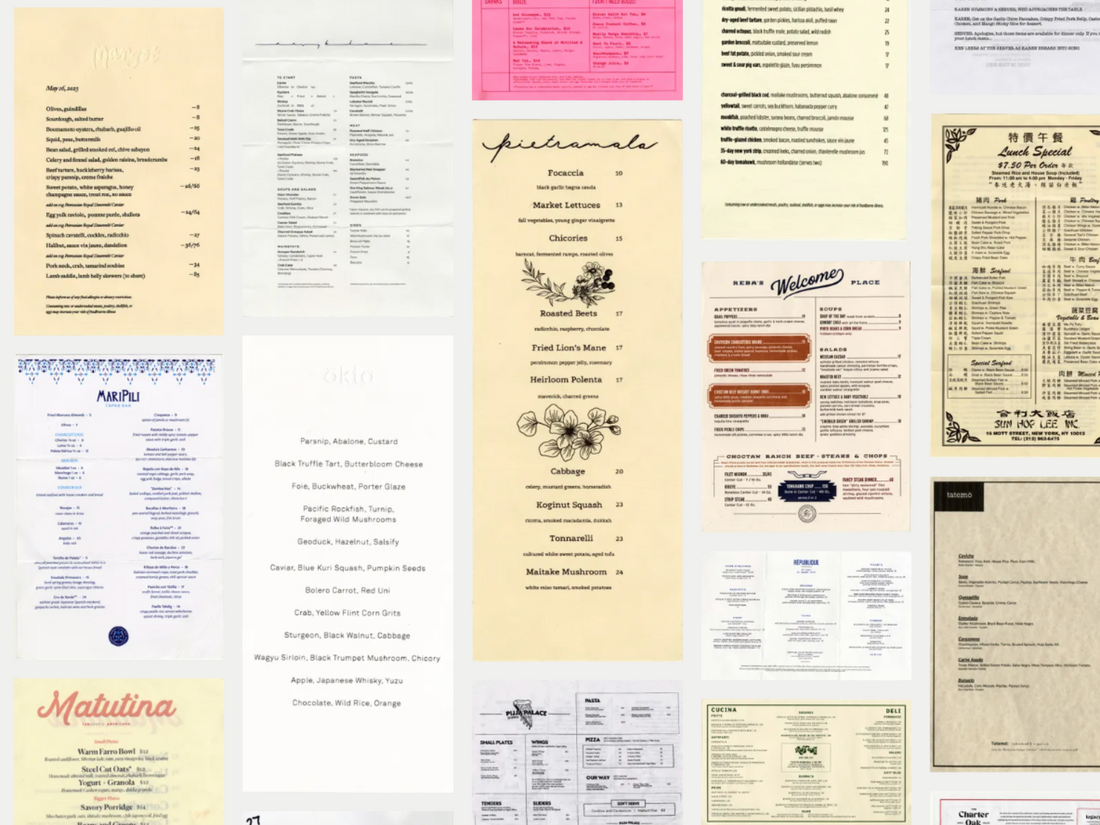The Evolution of Menu Design: From Classic Charm to Modern Trends
02.11.25
Intro
The menu is, in our opinion, the unsung hero of the dining experience. It’s the gateway to gastronomic adventure, the judge of our appetites, and sometimes, the source of our greatest deliberations (how many appetizers is too many?). But as we navigate the murky waters of modern dining, one has to wonder: is the art of the menu in peril? Join us as we stroll through the history of menu design, and ponder whether we’re losing a bit of that flavourful heritage.
Up to the 19th Century: A Gourmet Awakening
In 1765, in Paris, a visionary named Monsieur Boulanger opened a shop that sold bouillon—rich, concentrated stocks aimed at promoting health. His shop window boldly declared, "Come to me, all who suffer from stomach troubles, and I will restore you!" Ambitious and enterprising, Boulanger soon expanded his offerings. When he introduced leg of lamb in white sauce, the public eagerly embraced the dish, proving that he had a flair for not just healing but also pleasing the palate.
 Menu Design In America: John Mariani.
Menu Design In America: John Mariani.
When the French Revolution hit, chefs ditched their aristocratic shackles and took to the streets. Suddenly, bouillon shops like Monsieur Boulanger’s were all the rage, transforming into the dining hot spots of the era. Gone were the days of dusty kitchens; now it was all about white tablecloths, gleaming silverware, and centerpieces that would make even Marie Antoinette rethink her cake choices.

It's Nice That.
As much as tableware set the stage, it was the menu that played the leading role in the restaurant experience. By the mid-19th century, the humble signboard was swept off the scene, making way for the grand debut of the cartes du jour. Some were casual, printed on double-sided paper—perfect for those who just wanted to know what they were eating without the fuss. Others boasted thicker, beautifully designed pages that you might even consider framing. Meanwhile, train travel was picking up speed, and menus from the swanky first-class dining rooms of ocean liners—like those of the ever-so-chic Red Star and White Star lines—became so coveted that they turned into keepsakes. And let’s not forget the menus from elegant sleeper trains; after all, who doesn’t want a little nostalgia mixed in with their travel memories?
 Other White Star Line Vessels, 1932.
Other White Star Line Vessels, 1932.
The true game-changer came with the emergence of a la carte dining, which allowed patrons to choose individual dishes from a broader selection rather than being beholden to a pre-set menu. This opened up exciting new avenues for chefs to innovate, experiment, and express their culinary artistry. Such menu options didn’t just provide variety; they created an experience that embraced personal preference. Descriptions became more elaborate, enticing diners with phrases like “tender beef bourguignon” and “decadent crème brûlée.” Dining out became less about sustenance and more about exploration and indulgence—a social affair to be savoured and shared.
The 20th Century: A Menu for Every Mood

Feast.

McDonald's, Southfield, Michigan, USA, July 1978. Photo by Barbara Alper/Getty Images.
Future Trends

Hidden Taste 003.
Fashion and Beauty

Lisa Says Gah.

Emotional and Sensory

Yu & Mei.
Storytelling
Takeout Containers

NY Times.
AI Curated
 Menu Design In America: John Mariani.
Menu Design In America: John Mariani.
Sustainable
Signing Off with a Side of Sass
LINKS:
The Menu Trends That Define Dining Right Now.
The New York Public Library has a database of restaurant menus.
Vintage Restaurant Menus has some great designs.
